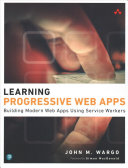
Learning Progressive Web Apps PDF
272 Pages·2020·33.0392 MB·other
Most books are stored in the elastic cloud where traffic is expensive. For this reason, we have a limit on daily download.
Preview Learning Progressive Web Apps
Description:
Developers building apps targeting desktops, laptops, smartphones, and tablets have two options to use when building their apps: native apps built specifically for the target platform, or web apps, which run on most any system. Building native apps for any target platform is a time-consuming and expensive proposition, especially when your app targets multiple system types (desktop computers, smartphones, televisions, etc.). Web apps are challenging because a user experiences vary dramatically depending on which type of system the user accessed the app from. Desktop browsers are fully capable, but mobile device browsers have limitations due to reduce screen real estate, processor speed, network bandwidth, and more. Many of these limitations have disappeared, but there's still considerable disparity between native app and web app capabilities. Over the years, web browsers, especially those running on mobile devices like smartphones and tablets, exposed more native capabilities to web apps. This enables web apps to work more like native apps, but there were still limitations. Service Workers are a relatively new technology that make it easier for web apps to bridge the gap between native and web capabilities, removing many limitations from web apps. This is a book about Service Workers, focusing on how to use Service Workers to enhance the capabilities of a web app to create a Progressive Web App (PWA). This book focuses on the technologies enabling PWAs, and how to use them to enhance your web apps to deliver a more native-like experience. Learning Progressive Web Apps is the first of a new generation of PWA guides that reflect breakthrough advances such as Service Workers and Web App Manifests, helping you combine the best features of web and mobile development. One step at a time, John M. Wargo introduces techniques for building apps, highlighting Building web apps a user can easily install on their local system Building web apps that work offline or on low quality networks Implementing caching strategies that give web developers control over which app resources are cached and when Delivering background processing in a web application Implementing push notifications to enable an app to more easily engage with users or trigger action from a remote server As you work through the chapters, at different points you'll start with one of three complete, stand-alone web apps, then convert them into PWAs using service workers and other browser technolo...
See more
The list of books you might like
Most books are stored in the elastic cloud where traffic is expensive. For this reason, we have a limit on daily download.
